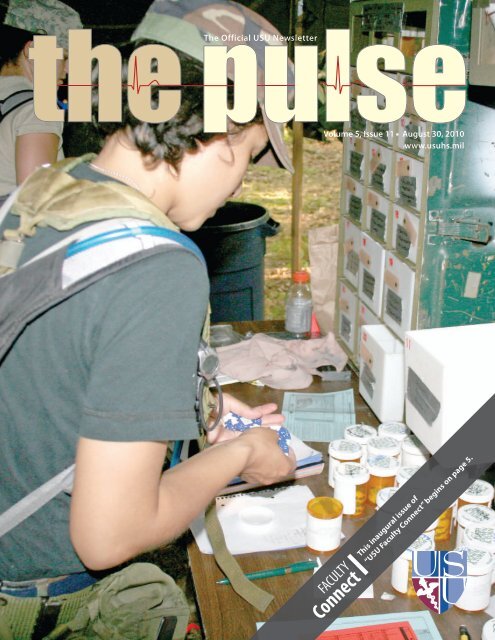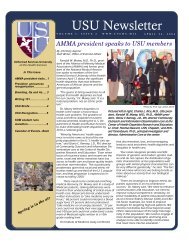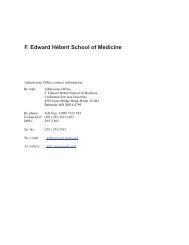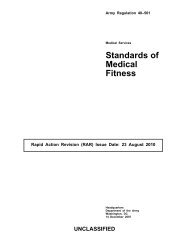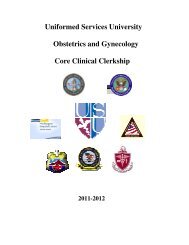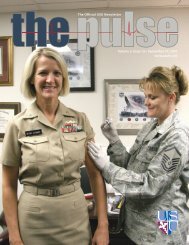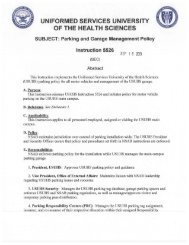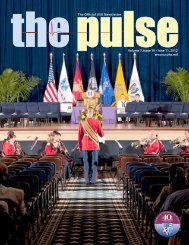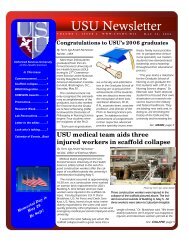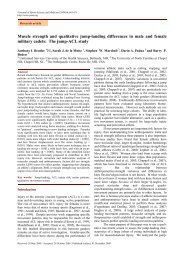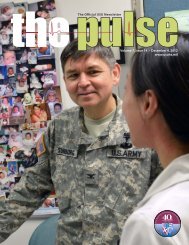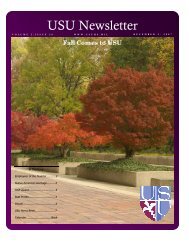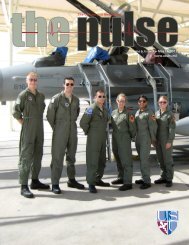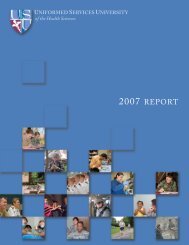Vol. 5, Issue 11 08/30/10 - Uniformed Services University of the ...
Vol. 5, Issue 11 08/30/10 - Uniformed Services University of the ...
Vol. 5, Issue 11 08/30/10 - Uniformed Services University of the ...
Create successful ePaper yourself
Turn your PDF publications into a flip-book with our unique Google optimized e-Paper software.
The Official USU Newsletter<br />
<strong>Vol</strong>ume 5, <strong>Issue</strong> <strong>11</strong> n August <strong>30</strong>, 20<strong>10</strong><br />
www.usuhs.mil<br />
This inaugural issue <strong>of</strong><br />
“USU Faculty Connect” begins on page 5.
Sharon Willis<br />
Acting Vice President for External<br />
Affairs and Managing Editor<br />
Ken Frager<br />
Public Affairs Specialist<br />
Staff Sgt. Mat<strong>the</strong>w Rosine<br />
Production Editor<br />
MC1 Chad Hallford<br />
Writer<br />
Christine Creenan-Jones<br />
Contributing Writer<br />
Lori Fields<br />
Layout and Design<br />
Production<br />
Editorial content is edited, prepared<br />
and provided by <strong>the</strong> USU Office <strong>of</strong><br />
External Affairs unless o<strong>the</strong>rwise<br />
indicated. The Pulse staff may<br />
include or exclude articles based<br />
upon news value, impact on <strong>the</strong><br />
university and space availability.<br />
USU Presents Faculty Connect<br />
by Charles L. Rice, M.D., President, USU<br />
If USU is to serve as <strong>the</strong> educational center <strong>of</strong> <strong>the</strong><br />
Military Health System (MHS), we need a full cadre <strong>of</strong><br />
dedicated and talented clinical faculty.<br />
It is critical that we optimize communications with<br />
our thousands <strong>of</strong> non-billeted faculty stationed at<br />
military treatment facilities around <strong>the</strong> United States<br />
and deployed worldwide.<br />
The inaugural issue <strong>of</strong> USU Faculty Connect included<br />
in this edition <strong>of</strong> The Pulse is an additional way to<br />
Photo by Thomas Balfour convey information about <strong>the</strong> resources and individuals<br />
who can appropriately recognize and reward <strong>the</strong><br />
hundreds <strong>of</strong> dedicated clinical faculty who serve USU throughout <strong>the</strong> MHS.<br />
It is my hope that improved communication from USU’s home campus<br />
to all <strong>of</strong> our teaching facilities will facilitate improved collaborations in our<br />
education and research efforts. I encourage you to read and enjoy this first<br />
issue <strong>of</strong> USU Faculty Connect.<br />
USU Alumnus takes helm at Naval Hospital<br />
Submissions<br />
The Pulse will be published<br />
bi-weekly on Mondays. The<br />
deadline for submissions is at 4 p.m.<br />
Tuesday prior to <strong>the</strong> publication<br />
date. Submissions can be sent to<br />
usunewsletter@usuhs.mil or by<br />
calling <strong>30</strong>1-295-<strong>08</strong>95.<br />
Courtesty Photo<br />
Photo by Sharon Willis<br />
On <strong>the</strong> cover<br />
A fourth year medical student works to<br />
to fill supply “orders” during <strong>the</strong> 20<strong>10</strong><br />
Bushmaster field training exercises.<br />
(See story page 3)<br />
Capt. Lynn Welling (USU SoM, ’89) assumed command <strong>of</strong> Naval Hospital<br />
Jacksonville July 29, relieving Capt. Bruce Gillingham (USU SoM, ’86), an<br />
orthopedic surgeon, who heads to Hawaii to become Fleet Surgeon for <strong>the</strong> U.S.<br />
Pacific Fleet.<br />
More than 400 staff and guests attended <strong>the</strong> ceremony, which featured speakers<br />
including Deputy Surgeon General, Vice Chief, Bureau <strong>of</strong> Medicine and<br />
Surgery Rear Adm. Thomas Cullison and Commander, Navy Medicine East and<br />
Naval Medical Center Portsmouth, Va., Rear Adm. “Mike” Stocks.<br />
Welling, a former naval aviator who flew <strong>the</strong> A-7 Corsair from <strong>the</strong> USS<br />
Dwight D. Eisenhower (CVN-69), now an emergency medicine doctor, returned<br />
in May 20<strong>10</strong> from his deployment as Commanding Officer, Expeditionary<br />
Medical Facility (EMF) Kuwait.<br />
Prior to his taking <strong>the</strong> helm at Naval Hospital Jacksonville in August 20<strong>08</strong>,<br />
Gillingham was Deputy Commander, Naval Medical Center Portsmouth. He<br />
also served as USU’s Associate Orthopaedic Residency Program Director for six<br />
years and as an assistant pr<strong>of</strong>essor <strong>of</strong> surgery.<br />
2 The Pulse The Official USU Newsletter
When <strong>the</strong> chips were down, <strong>the</strong> payout was success<br />
by Ken Frager<br />
Anyone with ties to <strong>the</strong> <strong>Uniformed</strong><br />
<strong>Services</strong> <strong>University</strong> <strong>of</strong> <strong>the</strong> Health Sciences<br />
(USU) knows <strong>the</strong> signature field training<br />
exercises, Operations Kerkesner and<br />
Bushmaster, are key differentiators from<br />
o<strong>the</strong>r medical schools.<br />
The primary mission <strong>of</strong> <strong>the</strong>se exercises<br />
has been to provide “real life” exposure<br />
to <strong>the</strong> realities <strong>of</strong> battlefield medicine. In<br />
fact, Dr. Jay Sanford, <strong>the</strong> first dean <strong>of</strong> <strong>the</strong><br />
F. Edward Hébert School <strong>of</strong> Medicine,<br />
directed <strong>the</strong> school’s faculty to test <strong>the</strong><br />
ability <strong>of</strong> <strong>the</strong> students to meet <strong>the</strong> second<br />
element <strong>of</strong> this educational objective.<br />
He envisioned this exercise not<br />
as “field training,” but as a “graduate<br />
level educational laboratory experience<br />
conducted in <strong>the</strong> field” during <strong>the</strong><br />
senior year <strong>of</strong> medical school.<br />
“Bushmaster and Kerkesner are<br />
events that medical students, when <strong>the</strong>y<br />
graduate and move on to <strong>the</strong>ir military<br />
careers, reflect back on and realize that<br />
<strong>the</strong>y really took away some good information,”<br />
said Army Lt. Col. (Dr.) Justin<br />
Woodson, co-director <strong>of</strong> this year’s<br />
Orientation with a twist<br />
by MC1 Chad Hallford<br />
USU’s incoming medical students<br />
were “initiated” to <strong>the</strong> <strong>University</strong> with<br />
a revamped orientation, likely unique<br />
to any o<strong>the</strong>r medical school.<br />
Described as “team-building,” <strong>the</strong><br />
new first-year medical student orientation<br />
included an obstacle course,<br />
knot training and “leading each o<strong>the</strong>r<br />
around blindly.”<br />
These activities, designed by<br />
current second-year students, served<br />
as “get to know” exercises that also<br />
were intended to be fun.<br />
“It was a way to start team-building,<br />
leadership training, encourage<br />
small group discussions and start <strong>the</strong><br />
process <strong>of</strong> developing <strong>of</strong>ficership,”<br />
said Navy company commander, Cdr.<br />
René Hernandéz.<br />
“We heard from previous classes<br />
that <strong>the</strong> zeal with which many new<br />
exercise and assistant pr<strong>of</strong>essor in <strong>the</strong><br />
Department <strong>of</strong> Military and Emergency<br />
Medicine. “But, <strong>the</strong>y also will realize<br />
that <strong>the</strong>ir exposure was only a fraction<br />
students entered <strong>the</strong> school was not<br />
used effectively, which led to classes<br />
missing opportunities to build<br />
camaraderie.” These missed opportunities<br />
delayed <strong>the</strong> ability <strong>of</strong> prior<br />
classes to establish comfort levels<br />
with <strong>the</strong>ir cross-service colleagues<br />
until much later in <strong>the</strong> curriculum.<br />
“This second-year class wanted to<br />
be mentors,” said Hernandéz. “They<br />
wanted to extend that arm <strong>of</strong> invitation<br />
and encourage <strong>the</strong> incoming<br />
students as <strong>the</strong>y start medical school.<br />
Whe<strong>the</strong>r it was successful in <strong>the</strong><br />
long-term remains to be seen, but it<br />
was an enjoyable exercise.”<br />
Photo by MC1 Chad Hallford<br />
Photo by Sharon Willis<br />
Two USU MS4 students inventory “supplies”—poker chips that were used during this year’s<br />
Bushmaster exercise. The chips represented specific supplies and medications, which added a new<br />
“reality” for <strong>the</strong> students.<br />
<strong>of</strong> what <strong>the</strong>y actually needed. Students<br />
are exposed not just to providing<br />
advanced life support in a field environment,<br />
but to establishing systems for<br />
improving patient movement.”<br />
Woodson and his colleagues, Army<br />
Lt. Col. James Schwartz and Army Lt.<br />
Col. (Dr.) Cliff Lutz, wanted to add<br />
some additional realism to <strong>the</strong> exercises<br />
and place more <strong>of</strong> a focus on logistics<br />
for this year’s participants. So <strong>the</strong>y<br />
constructed a plan that, according to<br />
<strong>the</strong> initial feedback, added a valuable<br />
missing element to <strong>the</strong> training.<br />
“Logistics in <strong>the</strong> field can make or<br />
break you,” said Woodson. “You are<br />
only as good as <strong>the</strong> equipment you<br />
have available when <strong>the</strong> injured service<br />
members arrive and especially during<br />
an actual deployment, equipment and<br />
supplies are usually very limited.”<br />
The planning team constructed a<br />
system using poker chips that could<br />
be used to signify specific supplies,<br />
medications and equipment.<br />
Each field hospital started an<br />
exercise with a medlog <strong>of</strong> 50 items,<br />
ranging from tourniquets to medications<br />
to ca<strong>the</strong>ters. A supply <strong>of</strong>ficer<br />
Continued to page 9<br />
August <strong>30</strong>, 20<strong>10</strong> 3
Cruder, Oakley named USU Junior,<br />
Senior Employees <strong>of</strong> <strong>the</strong> Quarter<br />
by Staff Sgt. Mat<strong>the</strong>w Rosine<br />
Alonzo Cruder<br />
Photo by Thomas Balfour<br />
The USU recently named two <strong>of</strong> its<br />
outstanding civilians as <strong>the</strong> Junior and<br />
Senior Employees <strong>of</strong> <strong>the</strong> Quarter.<br />
Alonzo Cruder, a program<br />
support assistant with <strong>the</strong> USU<br />
Department <strong>of</strong> Pharmacology, was<br />
named <strong>the</strong> Junior Employee <strong>of</strong><br />
<strong>the</strong> Quarter.<br />
Kevin Oakley, a research biologist<br />
with <strong>the</strong> USU Department <strong>of</strong> Pediatrics,<br />
was named <strong>the</strong> Senior Employee<br />
<strong>of</strong> <strong>the</strong> Quarter.<br />
These awards were based on <strong>the</strong>ir<br />
outstanding support and excellent<br />
service <strong>of</strong> <strong>the</strong> USU mission.<br />
Cruder, who has been with <strong>the</strong><br />
pharmacology department for seven<br />
years, is a diligent pr<strong>of</strong>essional as<br />
seen in his support <strong>of</strong> <strong>the</strong> Medical<br />
Pharmacology course. Cruder serves<br />
as <strong>the</strong> course administrator—organizing<br />
instructional materials, preparing<br />
student exams and recording grades<br />
in a thorough and timely manner.<br />
Over <strong>the</strong> past year, <strong>the</strong> Junior<br />
Employee <strong>of</strong> <strong>the</strong> Quarter has been<br />
exceptionally outstanding with his<br />
efforts to guarantee all academic and<br />
administrative deadlines are met as<br />
well as arranging <strong>the</strong> schedule for<br />
Kevin Oakley<br />
Photo by Thomas Balfour<br />
outside speakers to visit <strong>the</strong> <strong>University</strong>.<br />
Cruder ensured every guest speaker’s<br />
needs were pr<strong>of</strong>essionally handled<br />
including appropriate base access and<br />
reserved parking.<br />
He also guaranteed <strong>the</strong> flawless<br />
execution <strong>of</strong> small group quiz grading,<br />
coordinating with MDL for academic<br />
room scheduling and scheduling<br />
changes as well as critical support for<br />
approximately <strong>30</strong> Graduate School <strong>of</strong><br />
Nursing SRNA students to participate<br />
in <strong>the</strong> first 75 percent <strong>of</strong> <strong>the</strong> Medical<br />
Pharmacology course.<br />
“During <strong>the</strong> past year, Mr. Cruder<br />
has performed far above what would<br />
be considered outstanding,” said<br />
Jeffrey Harmon, Ph.D., Department <strong>of</strong><br />
Pharmacology pr<strong>of</strong>essor and chair. “I<br />
would not trade him for any two o<strong>the</strong>r<br />
USUHS staff members.”<br />
Oakley, who has three years experience<br />
in <strong>the</strong> department, provided his<br />
incredible commitment and experience<br />
toward ensuring excellence<br />
throughout <strong>the</strong> department. His<br />
tremendous efforts can clearly be seen<br />
in his superior ability to multitask as<br />
he supported two different laboratories<br />
in pediatrics. His support was<br />
even more critical because during this<br />
time <strong>the</strong> department was undergoing<br />
a temporary personnel shortage over a<br />
six month period.<br />
During one <strong>of</strong> <strong>the</strong>se projects,<br />
Oakley’s efforts led to <strong>the</strong> identification<br />
<strong>of</strong> several critical gene<br />
downstream <strong>of</strong> a novel oncogene in<br />
leukemia. His findings resulted in<br />
a publication and in help designing<br />
better <strong>the</strong>rapies for treating this<br />
disease that can affect both children<br />
and adults.<br />
As part <strong>of</strong> his efforts on a different<br />
assignment, Oakley single-handedly<br />
maintained a colony <strong>of</strong> more than 150<br />
cages <strong>of</strong> 500 transgenic mice. These<br />
mice contained extra genetic material<br />
integrated into <strong>the</strong>ir cells making<br />
<strong>the</strong>m useful models for <strong>the</strong> study <strong>of</strong><br />
human diseases.<br />
The Senior Employee <strong>of</strong> <strong>the</strong><br />
Quarter’s daily responsibilities<br />
included genotyping, weaning<br />
litters and managing mouse<br />
pedigree databases.<br />
“Over <strong>the</strong> years, Mr. Oakley has<br />
consistently exceeded expectations<br />
with a job performance that<br />
surpasses that <strong>of</strong> an average laboratory<br />
technician,” said Yang “Dennis”<br />
Du, Ph.D., Pediatrics assistant<br />
pr<strong>of</strong>essor. Oakley was also instrumental<br />
in obtaining preliminary data<br />
for a successful RO1 grant application<br />
for Dr. Du’s research. This is<br />
<strong>the</strong> first RO1 grant ever awarded in<br />
<strong>the</strong> USU Department <strong>of</strong> Pediatrics.<br />
“Besides carrying out experiments<br />
assigned to him in a timely fashion<br />
with high quality, he is always eager<br />
to learn about <strong>the</strong> science behind<br />
<strong>the</strong> experiments and to participate<br />
in presenting scientic articles in <strong>the</strong><br />
departmental journal club,” said Du.<br />
Mr. Oakley has become an essential<br />
member <strong>of</strong> <strong>the</strong> research program in<br />
<strong>the</strong> Department <strong>of</strong> Pediatrics and has<br />
contributed greatly to its success.”<br />
4 The Pulse The Official USU Newsletter
Office <strong>of</strong> <strong>the</strong> Associate Dean for Faculty Established<br />
by Larry W. Laughlin, M.D., Ph.D.<br />
Dean, F. Edward Hébert School <strong>of</strong> Medicine<br />
One <strong>of</strong> <strong>the</strong> keys<br />
to our successful<br />
clinical education<br />
efforts are<br />
<strong>the</strong> thousands <strong>of</strong><br />
hours <strong>of</strong> volunteer<br />
work done<br />
by USU School<br />
Photo by Thomas Balfour<br />
<strong>of</strong> Medicine<br />
faculty stationed at <strong>the</strong> more than 25<br />
military treatment facilities utilized<br />
for our third- and fourth-year<br />
medical student rotations. Enhanced<br />
communication is critical to improve<br />
<strong>the</strong> relationship between <strong>the</strong> School <strong>of</strong><br />
Medicine and its non-billeted faculty.<br />
For this reason, I established <strong>the</strong><br />
new Office <strong>of</strong> <strong>the</strong> Associate Dean<br />
for Faculty to serve as <strong>the</strong> liaison<br />
for communication and problemsolving<br />
between <strong>the</strong> home campus<br />
here in Be<strong>the</strong>sda, Maryland and<br />
each <strong>of</strong> your hospitals. I encourage<br />
you to contact your “home”<br />
academic department at USU or Dr.<br />
Brian Reamy, <strong>the</strong> Associate Dean<br />
for Faculty, for any questions or<br />
concerns that you have about issues<br />
related to your role as a faculty<br />
member <strong>of</strong> <strong>the</strong> School <strong>of</strong> Medicine. I<br />
hope that each <strong>of</strong> you feels welcome<br />
and stops by <strong>the</strong> campus if you are in<br />
Be<strong>the</strong>sda or meets with me or any <strong>of</strong><br />
<strong>the</strong> billeted USU faculty during our<br />
site visits throughout <strong>the</strong> academic<br />
year. I thank you for all <strong>of</strong> <strong>the</strong> expert<br />
work that you do on behalf <strong>of</strong> our<br />
students, residents, fellows and all <strong>of</strong><br />
our DoD beneficiaries.<br />
School <strong>of</strong> Medicine Faculty Appointment<br />
System Enhancement Begins<br />
by Brian Reamy, M.D., Associate Dean for Faculty<br />
Among <strong>the</strong><br />
growing pressures<br />
on faculty time is<br />
<strong>the</strong> demand for<br />
increased small<br />
group teaching and<br />
greater emphasis<br />
on providing<br />
Photo by Thomas Balfour<br />
instruction and<br />
patient care in <strong>the</strong> outpatient setting.<br />
Both require a dramatic increase in <strong>the</strong><br />
demand for faculty clinical time.<br />
In addition, as all services have<br />
faced physician retention problems<br />
in <strong>the</strong> face <strong>of</strong> an extraordinary<br />
deployment and operational tempo,<br />
uniformed faculty have decreased<br />
in number. All <strong>of</strong> this has occurred<br />
against a background <strong>of</strong> markedly<br />
increased competition for extramural<br />
research funding and <strong>the</strong> rising<br />
costs <strong>of</strong> increasingly sophisticated<br />
medical care.<br />
These pressures necessitate a<br />
re-evaluation and potential change<br />
in faculty appointment and promotion<br />
policies to reward and maintain<br />
<strong>the</strong> faculty who specialize in <strong>the</strong><br />
teaching <strong>of</strong> medical students while<br />
bearing large burdens <strong>of</strong> direct<br />
clinical care.<br />
A challenge for all medical schools<br />
is to build enough flexibility into<br />
<strong>the</strong>ir appointment and promotion<br />
policies to demonstrate that <strong>the</strong>y<br />
value <strong>the</strong> many different types <strong>of</strong><br />
faculty needed, ranging from bench<br />
scientists pushing <strong>the</strong> boundaries <strong>of</strong><br />
knowledge in <strong>the</strong>ir labs, to clinicians<br />
working in clinics and at <strong>the</strong> bedside<br />
with medical student clerks.<br />
Uniquely challenging to <strong>the</strong><br />
<strong>Uniformed</strong> <strong>Services</strong> <strong>University</strong> <strong>of</strong><br />
<strong>the</strong> Health Sciences (USU) is <strong>the</strong> fact<br />
that many <strong>of</strong> its clinical faculty are<br />
geographically very distant from <strong>the</strong><br />
home campus and <strong>the</strong>y <strong>of</strong>ten deploy<br />
to remote overseas locations for<br />
periods from six to fifteen months<br />
in duration. These deployments are<br />
essential for <strong>the</strong> success <strong>of</strong> <strong>the</strong> DoD<br />
mission, yet pull <strong>the</strong> faculty away<br />
from <strong>the</strong>ir teaching and clinical<br />
work. It is critical that <strong>the</strong> clinical<br />
faculty are not “punished” by loss <strong>of</strong><br />
appointments or promotions when<br />
<strong>the</strong>y perform <strong>the</strong>se vital overseas<br />
missions.<br />
Nationally, more than threefourths<br />
<strong>of</strong> U.S. medical schools<br />
have separate and distinct faculty<br />
tracks for full-time clinical faculty<br />
whose primary responsibilities are<br />
in clinical care. The majority <strong>of</strong><br />
schools that have this type <strong>of</strong> track<br />
modify <strong>the</strong> pr<strong>of</strong>essorial title with<br />
a “Clinical” prefix such as “Clinical<br />
Pr<strong>of</strong>essor <strong>of</strong> Medicine.”<br />
In May 2009, USU President<br />
Charles Rice convened a task force<br />
to review <strong>the</strong> existing appointment<br />
and promotion policies for clinical<br />
faculty at USU. The task force<br />
was charged with determining if<br />
Continued to page 7<br />
August <strong>30</strong>, 20<strong>10</strong> 5
Faculty Receive Privileges at<br />
USU Learning Resource Center<br />
by Brian Reamy, M.D., Associate Dean for Faculty<br />
One <strong>of</strong> <strong>the</strong> key benefits that<br />
accompany a current faculty<br />
appointment within <strong>the</strong> USU School<br />
<strong>of</strong> Medicine is <strong>the</strong> privilege <strong>of</strong><br />
24/7 access to <strong>the</strong> Learning Resource<br />
Center’s (LRC) Electronic Resources<br />
(ER) portal. This portal gives access<br />
to all <strong>of</strong> <strong>the</strong> major medical and<br />
scientific indexes and databases,<br />
full text references and more than<br />
9,000 unique journal titles and 400<br />
full electronic books. Almost all<br />
ER portal services are delivered<br />
over most web browsers permitting<br />
access for faculty members wherever<br />
<strong>the</strong>y are stationed or deployed across<br />
<strong>the</strong> globe.<br />
All USU faculty with a current<br />
appointment, whe<strong>the</strong>r billeted<br />
or non-billeted, may obtain<br />
access to <strong>the</strong> LRC’s ER portal,<br />
by simply applying for those<br />
services. To request access, go<br />
to <strong>the</strong> LRCs ER website at:<br />
http://er.lrc.usuhs.mil/index.<br />
phppage=account&signUp=form<br />
and provide <strong>the</strong> requested information.<br />
Once <strong>the</strong> LRC staff verifies<br />
with <strong>the</strong> USU personnel <strong>of</strong>fice<br />
that <strong>the</strong> faculty status is current,<br />
<strong>the</strong> application for access will be<br />
approved. At this time, borrowing<br />
<strong>of</strong> physical materials and interlibrary<br />
loans are among <strong>the</strong> privileges<br />
available to only those faculty<br />
members who are physically<br />
billeted at USU.<br />
Common problems that may<br />
prevent ER access include:<br />
n When faculty move to a new<br />
duty station and forget to<br />
update <strong>the</strong>ir faculty contact<br />
information with USU. The<br />
<strong>University</strong> personnel <strong>of</strong>fice<br />
is unable to provide verification<br />
<strong>of</strong> faculty status without<br />
current e-mail contact information.<br />
Faculty appointments<br />
are eventually dropped if <strong>the</strong><br />
personnel <strong>of</strong>fice does not<br />
hear back from <strong>the</strong> faculty<br />
with requests to send updated<br />
contact information or a current<br />
curriculum vitae.<br />
n If a new faculty member applies<br />
for LRC privileges before <strong>the</strong><br />
<strong>University</strong> personnel <strong>of</strong>fice has<br />
entered <strong>the</strong>ir name into <strong>the</strong> USU<br />
corporate database <strong>the</strong>n verification<br />
<strong>of</strong> faculty status cannot<br />
be provided. This problem can<br />
usually be solved with a phone<br />
call to <strong>the</strong> “home” academic<br />
Photo by Ken Frager<br />
department at USU to check <strong>the</strong><br />
status <strong>of</strong> a faculty appointment<br />
application prior to applying for<br />
LRC privileges.<br />
The Office <strong>of</strong> <strong>the</strong> Associate Dean<br />
for Faculty is always available to<br />
support resolution <strong>of</strong> unanticipated<br />
problems as well.<br />
The value <strong>of</strong> access to <strong>the</strong> ER<br />
portal cannot be understated.<br />
Several faculty have reported that<br />
one <strong>of</strong> <strong>the</strong> most robust and valuable<br />
aids <strong>the</strong>y have had in many austere<br />
deployed environments was access<br />
to <strong>the</strong> ER portal <strong>of</strong> <strong>the</strong> LRC for<br />
getting current diagnostic and<br />
<strong>the</strong>rapeutic information at <strong>the</strong><br />
point-<strong>of</strong>-care. All USU faculty are<br />
encouraged to take advantage <strong>of</strong><br />
this outstanding resource.<br />
6 The Pulse The Official USU Newsletter
SOM Opens new Faculty Advocate Office<br />
by Lisa McTigue, Office <strong>of</strong> <strong>the</strong> Associate Dean for Faculty<br />
The Office <strong>of</strong><br />
<strong>the</strong> Associate<br />
Dean for Faculty<br />
has been established<br />
to provide<br />
an advocate in<br />
<strong>the</strong> Dean’s Office<br />
to serve School <strong>of</strong><br />
Photo by Thomas Balfour<br />
Medicine faculty.<br />
The Associate Dean for Faculty,<br />
Col. (Dr.) Brian V. Reamy, USAF<br />
(Ret), serves as a faculty advisor<br />
and works to promote an academic<br />
environment that supports,<br />
enhances, and rewards <strong>the</strong> activities<br />
<strong>of</strong> all SOM faculty. Lisa McTigue,<br />
<strong>the</strong> Assistant to <strong>the</strong> Associate Dean<br />
for Faculty, will be providing <strong>the</strong><br />
administrative support for <strong>the</strong> <strong>of</strong>fice.<br />
With approximately 350 billeted<br />
faculty and 3,700 non-billeted<br />
faculty, <strong>the</strong>ir focus will be to<br />
provide support both through <strong>the</strong>ir<br />
on-campus <strong>of</strong>fice, and also through<br />
frequent site visits to military treatment<br />
facilities around <strong>the</strong> country.<br />
“It is our hope that by recognizing<br />
common obstacles in obtaining<br />
faculty appointments and/<br />
or promotions, working to open<br />
communication lines between<br />
USU and non-billeted faculty, and<br />
streamlining <strong>the</strong> application process<br />
by an anticipated electronic portfolio<br />
application, we will be able to<br />
assist with expediting <strong>the</strong> application<br />
process and to advocate for<br />
<strong>the</strong> needs <strong>of</strong> all School <strong>of</strong> Medicine<br />
faculty,” said Reamy.<br />
Dr. Reamy, and Ms. McTigue<br />
are available via email at breamy@<br />
usuhs.mil, lmctigue@usuhs.mil, by<br />
phone at (<strong>30</strong>1) 319-0349/9437, and<br />
are located in room A<strong>10</strong><strong>08</strong> on <strong>the</strong><br />
USU campus.<br />
System<br />
Enhancement Begins<br />
Continued from page 5<br />
changes were needed to appropriately<br />
recognize and incentivize<br />
<strong>the</strong> hundreds <strong>of</strong> volunteer clinical<br />
faculty that <strong>the</strong> school <strong>of</strong> medicine<br />
utilizes to deliver teaching across<br />
its third and fourth year clinical<br />
clerkships. The task force released<br />
several recommendations.<br />
Among <strong>the</strong> recommendations were to:<br />
n Maintain <strong>the</strong> current faculty<br />
appointment and promotion<br />
system for clinical faculty<br />
that provides for tenured or<br />
non-tenured appointments as well<br />
as two pathways for promotion;<br />
clinician-investigator and clinicianeducator.<br />
These appointments and<br />
promotions would be non-prefixed.<br />
n Continue <strong>the</strong> initial appointment<br />
<strong>of</strong> all clinical faculty in <strong>the</strong> School<br />
<strong>of</strong> Medicine as non-prefixed<br />
Assistant Pr<strong>of</strong>essors.<br />
n Increase <strong>the</strong> flexibility available<br />
to USU to reward and recognize<br />
<strong>the</strong> tremendous work <strong>of</strong> clinical<br />
faculty by restoring <strong>the</strong> option<br />
<strong>of</strong> a prefixed appointment at <strong>the</strong><br />
Associate or full Pr<strong>of</strong>essor level<br />
(e.g. Clinical Associate Pr<strong>of</strong>essor<br />
<strong>of</strong> specialty).<br />
These recommendations went<br />
into effect on July 1, 20<strong>10</strong>. The<br />
prefix “Clinical” may be used by <strong>the</strong><br />
USU Department Chair for those at<br />
<strong>the</strong> rank <strong>of</strong> Associate or Full Pr<strong>of</strong>essor.<br />
It is reserved for tenure-ineligible<br />
individuals whose primary<br />
contributions to <strong>the</strong> SOM are in<br />
clinical teaching, clinical practice or<br />
clinical administration.<br />
Due to <strong>the</strong> limited time afforded<br />
<strong>the</strong>se clinical faculty to work in<br />
traditional scholarly activities, <strong>the</strong>ir<br />
appointments will be judged based<br />
on <strong>the</strong>ir achievements and recognition<br />
in teaching, clinical practice and<br />
clinical administration. Eligibility for<br />
appointment as a Clinical Associate<br />
Pr<strong>of</strong>essor would require a minimum<br />
time in rank as an assistant pr<strong>of</strong>essor<br />
<strong>of</strong> six years as well as excellence<br />
in teaching and clinical care while<br />
serving as a pr<strong>of</strong>essional role-model<br />
for peers and achieving institutional<br />
recognition as an outstanding clinician<br />
and clinical teacher.<br />
Similarly, appointment as a Clinical<br />
Pr<strong>of</strong>essor would include <strong>the</strong> same<br />
criteria as for a clinical Associate<br />
Pr<strong>of</strong>essor AND Service - wide or<br />
National recognition as a clinician<br />
and clinical teacher and a minimum<br />
time in rank as an assistant and/or<br />
associate pr<strong>of</strong>essor <strong>of</strong> ten years.<br />
These appointments would<br />
require a letter from <strong>the</strong> USU<br />
Chair explaining and supporting<br />
<strong>the</strong> request, <strong>the</strong> faculty member’s<br />
CV, a letter <strong>of</strong> support from a<br />
faculty member <strong>of</strong> senior academic<br />
rank in <strong>the</strong> applicant’s specialty<br />
and endorsement by <strong>the</strong> faculty<br />
member’s Commanding Officer.<br />
After all forms are received<br />
and approved by <strong>the</strong> applicant’s<br />
specialty department at USU, <strong>the</strong><br />
appointment would be reviewed by<br />
<strong>the</strong> SOM Committee on Appointments,<br />
Promotions and Tenure.<br />
Any questions about <strong>the</strong> process or<br />
appropriateness <strong>of</strong> pursuing a Clinical<br />
prefixed appointment can be directed<br />
to <strong>the</strong> faculty member’s USU department<br />
or Dr. Brian Reamy, Associate<br />
Dean for Faculty, at breamy@usuhs.mil.<br />
August <strong>30</strong>, 20<strong>10</strong> 7
Science, Service, Medicine and Mentoring<br />
by Ken Frager<br />
Ensign John Roman was a mentor<br />
for <strong>the</strong> <strong>Uniformed</strong> <strong>Services</strong> <strong>University</strong><br />
<strong>of</strong> <strong>the</strong> Health Sciences’ Science,<br />
Service, Medicine and Mentoring<br />
(S2M2) program two years ago.<br />
Now a third year medical student<br />
completing an OB/GYN rotation at<br />
<strong>the</strong> National Naval Medical Center,<br />
Roman returned to evaluate <strong>the</strong><br />
participants in <strong>the</strong> 20<strong>10</strong> program and<br />
he was impressed by what he<br />
has seen.<br />
“These students are presenting<br />
research much higher than where I<br />
was at <strong>the</strong>ir age,” said Roman, “and<br />
<strong>the</strong>y really seem to be enjoying <strong>the</strong>ir<br />
experience.” The students, from across<br />
<strong>the</strong> country, took part in <strong>the</strong> weeklong<br />
summer program that gives high<br />
school students who have an interest<br />
in a future in medicine, exposure <strong>the</strong>y<br />
might not o<strong>the</strong>rwise get.<br />
“Most <strong>of</strong> <strong>the</strong>se young people don’t<br />
have exposure to medical pr<strong>of</strong>essionals<br />
in <strong>the</strong>ir families or environments,<br />
so <strong>the</strong>y don’t have <strong>the</strong> opportunity to<br />
really see, first hand, what <strong>the</strong> fields<br />
<strong>of</strong> medicine and science are really all<br />
about,” said Roman. “This experience,<br />
which really is a lot <strong>of</strong> work<br />
over <strong>the</strong> one week session, will give<br />
<strong>the</strong>m a leg up on <strong>the</strong>ir classmates<br />
No longer collecting dust<br />
by MC1 Chad Hallford<br />
Maintaining a historical documentation<br />
<strong>of</strong> <strong>the</strong> <strong>Uniformed</strong> <strong>Services</strong> <strong>University</strong> <strong>of</strong> <strong>the</strong><br />
Health Sciences has taken on a digital life,<br />
with <strong>the</strong> integration or expansion <strong>of</strong> online<br />
sharing websites like Flickr and improved<br />
archival resources. Recently, <strong>the</strong> <strong>University</strong><br />
Archives team opened <strong>the</strong>ir doors for tours<br />
and education.<br />
Established in June 2000 with <strong>the</strong> mission<br />
to identify, collect, preserve and promote<br />
<strong>the</strong> historical relevance <strong>of</strong> <strong>the</strong> USU and <strong>of</strong><br />
military medicine, <strong>the</strong> archives team has<br />
broken down into three main categories:<br />
rare <strong>University</strong> material; historical military<br />
Continued to page <strong>10</strong><br />
8 The Pulse The Official USU Newsletter<br />
Photo by Ken Frager<br />
Navy Ensign John Roman listens while<br />
Emelda Kobba, a rising senior at Wheaton<br />
High School in Silver Spring, Maryland,<br />
discussed her research on Encephalitis<br />
during <strong>the</strong> 20<strong>10</strong> S2M2 sessions.<br />
when it comes time to apply for<br />
medical school.”<br />
The S2M2 program exposes participating<br />
high school students to <strong>the</strong><br />
medical field with an inside view<br />
<strong>of</strong> what it would be like in medical<br />
school and <strong>the</strong> pr<strong>of</strong>essions that follow,<br />
under <strong>the</strong> watchful eyes <strong>of</strong> student and<br />
faculty mentors.<br />
Akhilesh Kumar, a rising high<br />
school senior from Livermore,<br />
California, learned about <strong>the</strong> S2M2<br />
program while researching summer<br />
programs online. Kumar, who is<br />
interested in a career in medicine<br />
“and probably cardiology,” and his<br />
partner presented <strong>the</strong>ir research<br />
on Ayurvedic Medicine, a complementary<br />
form <strong>of</strong> medicine used to<br />
supplement traditional medicine,<br />
during <strong>the</strong> final research fair. “I<br />
don’t have any medical researchers<br />
or military in my family, but I was<br />
interested in learning more,” he said.<br />
“Now I think I would be interested in<br />
joining <strong>the</strong> Navy and <strong>the</strong>n continuing<br />
with a medical degree.”<br />
Navy Capt. (Dr.) Margaret Calloway,<br />
associate dean for recruitment<br />
and admissions at <strong>the</strong> USU’s F.<br />
Edward Hébert School <strong>of</strong> Medicine,<br />
believes <strong>the</strong> S2M2 program is an<br />
important tool for <strong>the</strong> <strong>University</strong> in<br />
recruiting <strong>the</strong> best and <strong>the</strong> brightest<br />
future students. “These students are<br />
building a foundation for <strong>the</strong>ir future<br />
in research and medicine, while also<br />
getting valuable exposure to military<br />
medicine,” she said. “The topics <strong>the</strong>y<br />
are choosing for <strong>the</strong>ir final research<br />
projects are generally focused on<br />
health disparities and tend to be those<br />
that might be helpful when <strong>the</strong>y get<br />
back into <strong>the</strong>ir communities.” Topics<br />
included Munchausen syndrome,<br />
encephalitis, in-vitro fertilization and<br />
Marfan syndrome, smallpox, along<br />
with Kumar’s presentation.<br />
Photo by MC1 Chad Hallford<br />
Emelie Rubin, USU’s institutional archivist, explains <strong>the</strong> unique history behind several<br />
pieces <strong>of</strong> <strong>the</strong> <strong>University</strong>’s collection within <strong>the</strong> archives at <strong>the</strong> LRC.
USU gets new decals<br />
by Staff Sgt. Mat<strong>the</strong>w Rosine<br />
The USU is getting updated decals<br />
for privately owned vehicles.<br />
The process will be done over <strong>the</strong><br />
next several months by <strong>the</strong> Naval<br />
Support Activity Be<strong>the</strong>sda (NSAB)<br />
Pass and ID Office.<br />
The decal update is necessary because<br />
NSAB is transitioning to a new database<br />
housing all registered vehicle information.<br />
All students, faculty and staff <strong>of</strong><br />
USU will be issued new decals in accordance<br />
with <strong>the</strong> new <strong>of</strong>fice guidance.<br />
The NSAB has not yet established a<br />
schedule for <strong>the</strong> re-issuing <strong>of</strong> decals for<br />
USU personnel. The schedule will be<br />
a guide for incoming customers. The<br />
guide will be based on a customer’s last<br />
name and should help avoid excessively<br />
long lines from delaying its services.<br />
Decals available to USU faculty,<br />
students and staff will vary depending<br />
on <strong>the</strong>ir needs. Decals available are:<br />
DoD Decal: Customers who currently<br />
have a DoD decal on <strong>the</strong>ir vehicles<br />
will not be required to receive<br />
ano<strong>the</strong>r. However, <strong>the</strong>y will need<br />
to bring <strong>the</strong> DoD Decal number to<br />
<strong>the</strong> distribution location in order to<br />
catalog <strong>the</strong> number with <strong>the</strong> Pass<br />
and ID <strong>of</strong>fice.<br />
Chips were down...<br />
Continued from page 3<br />
was responsible for maintaining<br />
appropriate levels <strong>of</strong> supplies, while<br />
following “real-time” processes for<br />
receiving new stock from <strong>the</strong> base<br />
command, including processes for<br />
ordering similar to those used in a<br />
true combat situation.<br />
Army 2nd Lt. Jeevna Kaur served as<br />
<strong>the</strong> primary medical logistics <strong>of</strong>ficer for<br />
<strong>the</strong> exercises and said she was initially<br />
skeptical that <strong>the</strong> approach to creating<br />
realism would work.<br />
“When we first evaluated <strong>the</strong> plan I<br />
wasn’t clear that it would accomplish<br />
<strong>the</strong> goal we had set,” said Kaur. “But<br />
once it got underway I found that it<br />
Installation Decal: Customers<br />
who currently have a <strong>Uniformed</strong><br />
<strong>Services</strong> <strong>University</strong>, AFRRI, NNMC<br />
or NAVDIST WASH decal will be<br />
able to keep this on <strong>the</strong>ir vehicles.<br />
However, <strong>the</strong>y will need to notify<br />
<strong>the</strong> Pass and ID <strong>of</strong>fice staff at distribution<br />
<strong>of</strong> this current sticker.<br />
Expiration Date Decal: Customers<br />
who have a current month and<br />
year expiration date for <strong>the</strong>ir decals,<br />
need to notify <strong>the</strong> Pass and ID staff<br />
during registration.<br />
Parking Decal: New parking decals<br />
will be issued with <strong>the</strong> following<br />
designations:<br />
“W” - Parking garage at USUHS.<br />
“N” – “N” Lot and “N” Executive Lot<br />
at AFRRI.<br />
“L-1” - Carpool or Vanpool.<br />
Additionally customers should be aware<br />
that <strong>the</strong> Pass and ID Office has an application.<br />
The application is in a fillable PDF<br />
format. This document is required to be<br />
completed to receive decals. Customers are<br />
asked to print <strong>the</strong> two-sided document,<br />
sign it and bring it to <strong>the</strong> distribution.<br />
The guidelines for carpools is<br />
currently being finalized. More<br />
really did seem to add a higher level <strong>of</strong><br />
anxiety and excitement.<br />
“In <strong>the</strong> past, if a student needed a<br />
chest tube for a patient, all <strong>the</strong>y had<br />
to do was pretend <strong>the</strong>y had one and<br />
<strong>the</strong>n pretend to insert it,” said Kaur.<br />
“With <strong>the</strong> new system, if a student<br />
didn’t have a ‘chip’ for a chest tube,<br />
ei<strong>the</strong>r because <strong>the</strong>y had already used<br />
<strong>the</strong>ir allotment or because <strong>the</strong>ir<br />
supply <strong>of</strong>ficer didn’t request one,<br />
<strong>the</strong>n <strong>the</strong>y were forced to find ano<strong>the</strong>r<br />
way to care for <strong>the</strong>ir patient. The<br />
students seemed to really grasp that<br />
while logistics might be a pain, it is a<br />
critical element.”<br />
guidance will be distributed later<br />
for customers.<br />
Customers are also required to bring<br />
certain documentation with <strong>the</strong>m for<br />
registration. These documents are:<br />
The application form, filled out,<br />
printed and signed<br />
A CAC, military, government<br />
employee or contractor ID card<br />
Driver’s license<br />
Vehicle registration for each vehicle<br />
being registered<br />
Pro<strong>of</strong> <strong>of</strong> valid insurance for each<br />
vehicle being registered<br />
Carpool agreement for all members<br />
<strong>of</strong> a current or proposed carpool<br />
DoD decal number (if a current<br />
decal is on <strong>the</strong> vehicle)<br />
Installation decal name (if valid)<br />
Expiration date <strong>of</strong> month and year<br />
sticker (if valid)<br />
Any scraped expired and/or<br />
invalid decals<br />
All new DoD vehicle decals and parking<br />
assignment stickers must be in place by<br />
Jan. 1, 20<strong>11</strong>. After that date, all privately<br />
owned vehicles entering <strong>the</strong> installation<br />
must display valid DoD decals or <strong>the</strong><br />
operator must obtain a visitor’s pass.<br />
This added layer <strong>of</strong> realism helped<br />
improve this year’s operations – as planned.<br />
“Our intent was to create more<br />
realism and provide some additional<br />
value for <strong>the</strong> students, and I think<br />
we accomplished that this year,” said<br />
Schwartz. “Our philosophy was to<br />
evolve Bushmaster into a broader and<br />
deeper exercise, preparing <strong>the</strong> students<br />
to become better command surgeons in<br />
<strong>the</strong> field. To really be effective requires<br />
<strong>the</strong>y handle logistics, reporting, patient<br />
tracking, planning and mission execution.<br />
This year, we touched all <strong>of</strong> <strong>the</strong>se<br />
areas and <strong>the</strong> students handled <strong>the</strong><br />
pressure pretty well.”<br />
August <strong>30</strong>, 20<strong>10</strong> 9
What’s cooking in <strong>the</strong> USU Cafeteria<br />
by MC1 Chad Hallford<br />
USU Collections...<br />
Continued from page 8<br />
There have been some significant<br />
changes in <strong>the</strong> USU Cafeteria since<br />
Jamie’s General Bean’s (JGB) moved in,<br />
and more are coming.<br />
Since taking over operations on <strong>the</strong><br />
Memorial Day weekend, and navigating<br />
<strong>the</strong> initial challenges associated<br />
with <strong>the</strong> USU kitchen and equipment,<br />
JGB continues to provide its customers<br />
with an ever-improving, wholesome<br />
menu to sample daily.<br />
“It has been a challenge trying to<br />
blend and balance between some<br />
<strong>of</strong> our customers needs for a quick,<br />
ready-to-eat menu and o<strong>the</strong>rs who<br />
will wait for a healthier made-to-order<br />
option,” said Kathryn Troutman. “But<br />
we always welcome feedback and we<br />
have more changes planned for <strong>the</strong><br />
near future.”<br />
One major area <strong>of</strong> interest is <strong>the</strong><br />
lobby <strong>of</strong> Building C. “We intend<br />
to place a full service c<strong>of</strong>fee kiosk,<br />
with sandwiches and salads, with<br />
Something from <strong>the</strong>ir menu…<br />
Kath’s Spicy Yam Salad<br />
4-6 large yams<br />
(also nice with sweet potatoes, if<br />
available)<br />
3-4 ears <strong>of</strong> fresh sweet corn<br />
1/2 red onion<br />
1 red bell pepper<br />
Prick <strong>the</strong> yams with a fork and<br />
roast <strong>the</strong>m at 450F until tender -<br />
about 40 minutes. You don’t want<br />
<strong>the</strong>m to be too s<strong>of</strong>t, or <strong>the</strong>y won’t<br />
hold up in <strong>the</strong> salad. Let <strong>the</strong>m cool<br />
completely. It is best to do this<br />
step <strong>the</strong> day before making <strong>the</strong><br />
salad. If time is an issue, <strong>the</strong> yams<br />
can be peeled, cut into 1 inch<br />
cubes and steamed.<br />
When <strong>the</strong> yams are completely cool,<br />
slip <strong>of</strong>f <strong>the</strong>ir skins and cut <strong>the</strong>m into<br />
1 inch cubes.<br />
Steam or boil <strong>the</strong> corn just until<br />
cooked. Let it cool enough to<br />
handle, <strong>the</strong>n slice <strong>of</strong>f <strong>the</strong> kernels.<br />
<strong>the</strong> hope <strong>of</strong> expanding to include<br />
smoothies, among o<strong>the</strong>r options on<br />
that menu,” said Troutman. “We are<br />
waiting as <strong>the</strong> <strong>University</strong> improves<br />
<strong>the</strong> utility infrastructure in that<br />
area, but hope to make that a<br />
reality soon.”<br />
Perhaps <strong>the</strong> most welcome change<br />
was that <strong>of</strong> <strong>the</strong> ability to accept credit<br />
cards. “We realized this was a critical<br />
issue for many people since <strong>the</strong>re<br />
is no convenient bank or ATM on <strong>the</strong><br />
campus and thanks to <strong>the</strong> support<br />
<strong>of</strong> everyone involved that has been<br />
resolved,” said Troutman.<br />
O<strong>the</strong>r services have expanded<br />
within <strong>the</strong> cafeteria, including<br />
various levels <strong>of</strong> catering throughout<br />
<strong>the</strong> <strong>University</strong>. From pre-packaged<br />
working lunches to executive multicourse<br />
dining, with many options in<br />
between, JGB strives to ensure <strong>the</strong><br />
<strong>University</strong> will be eating well for as<br />
long as <strong>the</strong>y can provide <strong>the</strong> menu.<br />
1 16oz can <strong>of</strong> black beans<br />
cilantro (as much or as little as you<br />
wish)<br />
Chipotle Tabasco sauce<br />
juice from 4-5 limes<br />
Cut <strong>the</strong> red onion in half and slice<br />
lengthwise into thin slivers. Dice<br />
<strong>the</strong> red bell pepper.<br />
Drain and rinse <strong>the</strong> black beans.<br />
Finely chop <strong>the</strong> cilantro leaves.<br />
Combine all <strong>of</strong> <strong>the</strong> above.<br />
Mix Chipotle Tabasco with <strong>the</strong><br />
fresh lime juice, pour <strong>the</strong> mixture<br />
over <strong>the</strong> salad ingredients, add<br />
a bit <strong>of</strong> salt and black pepper to<br />
taste and toss. I never measure<br />
this, so adjust <strong>the</strong> amount <strong>of</strong><br />
Tabasco to your taste.<br />
medical and public health collections;<br />
and personal papers <strong>of</strong> enduring value<br />
from administrators, faculty and<br />
alumni for <strong>the</strong> research use <strong>of</strong> <strong>University</strong><br />
staff, students, scholars and <strong>the</strong><br />
general public.<br />
USU archivist Emelie Rubin and<br />
archival assistants Megan Guglielmi<br />
and Ka<strong>the</strong>rine Ferguson, are responsible<br />
for maintaining <strong>the</strong> <strong>University</strong><br />
collections, which include historical<br />
documents dating from <strong>the</strong> 1500’s,<br />
along with USU Board <strong>of</strong> Regents<br />
meeting minutes since its inception<br />
in 1972.<br />
“The original manuscript <strong>of</strong> <strong>the</strong><br />
<strong>University</strong>’s alma mater, photos<br />
from commencements and university<br />
construction, <strong>the</strong> act signed<br />
by President Nixon to establish<br />
<strong>the</strong> <strong>University</strong>, all are available for<br />
viewing,” said Rubin. “We also have<br />
many unique instruments that have<br />
impacted <strong>the</strong> history <strong>of</strong> <strong>the</strong> <strong>University</strong>.<br />
Our hope is that <strong>the</strong>y will be<br />
viewed and used by many groups.”<br />
The archives also include oral history<br />
statements from many <strong>of</strong> <strong>the</strong> <strong>University</strong>’s<br />
founders and key leaders,<br />
developed beginning in 2005, which<br />
is a growing part <strong>of</strong> <strong>the</strong> institutional<br />
archivists responsibilities.<br />
“We have interviewed more than 35<br />
prominent figures throughout USU’s<br />
history and transcribed some <strong>of</strong> <strong>the</strong>ir<br />
interviews into searchable texts, available<br />
online,” said Rubin<br />
Additional information about <strong>the</strong><br />
archives is available at http:// er.lrc.<br />
usuhs.mil/archives.<br />
<strong>10</strong> The Pulse The Official USU Newsletter
Briefs<br />
ESC Burrito sale<br />
The Enlisted Social Committee is<br />
planning an upcoming food fundraiser.<br />
The ESC will be having a Breakfast<br />
Burrito sale Sept. 2, 9 and 16 in <strong>the</strong><br />
atrium outside <strong>of</strong> <strong>the</strong> Sanford auditorium.<br />
The sale begins at 6 a.m. and will<br />
end at 9:<strong>30</strong> a.m. or until all items have<br />
been sold.<br />
For more information about <strong>the</strong> sales<br />
ask an ESC member or contact <strong>the</strong> ESC<br />
by e-mail at esc@usuhs.mil. The ESC<br />
meets <strong>the</strong> first Tuesday <strong>of</strong> every month<br />
at 9:<strong>30</strong> a.m. in <strong>the</strong> small dining room<br />
unless o<strong>the</strong>rwise rescheduled.<br />
Pr<strong>of</strong>essional activities<br />
The Department <strong>of</strong> Defense<br />
and USU policy requires that all<br />
employees, both military and civilian,<br />
receive approval for engaging<br />
in any activity outside <strong>the</strong>ir work<br />
environment, which involves <strong>the</strong>ir<br />
pr<strong>of</strong>essional expertise or government<br />
occupation (whe<strong>the</strong>r or not<br />
compensated), as well as any activity<br />
that involves compensation. This<br />
includes serving on <strong>the</strong> Board <strong>of</strong> a<br />
Non-Federal Organization.<br />
This approval is required prior to<br />
engaging in <strong>the</strong> activity. In order to get<br />
approval, any employee can complete a<br />
USU Form <strong>10</strong>04. This completed form<br />
must be approved and signed by each<br />
department chair or activity head.<br />
These forms are available in <strong>the</strong><br />
General Counsel’s <strong>of</strong>fice or online at<br />
<strong>the</strong> USU OGC Web site. Completed<br />
forms must be turned in to <strong>the</strong> General<br />
Counsel’s <strong>of</strong>fice. The form will be<br />
routed to <strong>the</strong> appropriate dean, brigade<br />
commander or USU president.<br />
Once processing is completed, a<br />
copy <strong>of</strong> <strong>the</strong> approved form will be<br />
returned to <strong>the</strong> employee for <strong>the</strong><br />
employee’s records.<br />
RCR Education Conference<br />
Registration is now open for <strong>the</strong> Sept.<br />
28th Responsible Conduct <strong>of</strong> Research<br />
Educational Conference being held at<br />
<strong>the</strong> USU’s Sanford Auditorium.<br />
The conference is being sponsored<br />
by <strong>the</strong> USU Office <strong>of</strong> <strong>the</strong> President<br />
and <strong>the</strong> Graduate School <strong>of</strong> Nursing<br />
in partnership with <strong>the</strong> new Navy<br />
Medicine Institute for <strong>the</strong> Medical<br />
Humanities and Research Leadership<br />
and <strong>the</strong> Smithsonian Institution’s<br />
Office <strong>of</strong> Sponsored Projects.<br />
The free conference, entitled<br />
“Promoting <strong>the</strong> Global Good: The<br />
Social Responsibility <strong>of</strong> Scientists and<br />
Researchers,” will address an emergent<br />
subject in RCR Education—<strong>the</strong> social<br />
responsibility <strong>of</strong> scientists.<br />
This was recently included in new<br />
NIH RCR education requirements.<br />
The conference may be able to assist<br />
individuals with completing RCR<br />
education requirements.<br />
Full registration information,<br />
including directions, are available for<br />
download at: http://www.<strong>the</strong>chiefinformationgroup.com/conference/<br />
usuhs/index.phpc_id=15<br />
Using Computer Resources<br />
Security incidents continue to be a<br />
drain to limited USU Information Assurance<br />
manpower. The following highlight<br />
current DoD policy and best practices:<br />
Personnel must not install selfcoded<br />
or non-licensed s<strong>of</strong>tware on<br />
network resources; add, remove,<br />
configure, or attempt to modify<br />
USU computer operating systems<br />
or programs; move audio/visual or<br />
network cables, computers or attempt<br />
to connect personal computers<br />
to <strong>the</strong> network including MDL and<br />
lecture hall spaces; connect personal<br />
devices except for those previously<br />
authorized by NOC; download<br />
pornographic material and store or<br />
display <strong>of</strong>fensive material, such as<br />
racist literature, sexually harassing or<br />
obscene language or material or store<br />
or process classified information on<br />
any USU system.<br />
Personnel must not permit unauthorized<br />
individuals access to a<br />
government-owned or governmentoperated<br />
system or program; or access<br />
online gambling, games and social<br />
engineering sites.<br />
Helpdesk Closure<br />
The NOC helpdesk is closed for training<br />
on Thursdays from <strong>10</strong> to <strong>11</strong> a.m.<br />
During this time, you can leave a<br />
voicemail message at 295-9800, utilize<br />
<strong>the</strong> HEAT Self Service (http://www.<br />
usuhs.mil/uis/forms/trouble.html), or<br />
email help@usuhs.mil.<br />
If an emergency should arise, please<br />
call 295-9870.<br />
Exercise/Fitness Areas<br />
Physical fitness training should be<br />
conducted in designated areas.<br />
The only authorized space for PT<br />
within <strong>the</strong> university is room G060.<br />
The campus’ Student Community<br />
Lounge area is also authorized, but<br />
only during specified PFT testing<br />
dates or times.<br />
USU-HJF Military Medicine<br />
Symposium: Advancing<br />
Public-Private Partnerships<br />
Thursday, September 23, 20<strong>10</strong><br />
7:<strong>30</strong> a.m.-6:<strong>30</strong> p.m.<br />
Omni Shoreham Hotel<br />
Washington, D.C.<br />
For <strong>the</strong> full agenda, along with<br />
registration and exhibitor information,<br />
visit www.hjfcp3.org/<br />
events/20<strong>10</strong>-symposium/.<br />
For fur<strong>the</strong>r information, contact<br />
Jackie Vandermeersch at (<strong>30</strong>1) 294-1441<br />
or jvandermeersch@hjf.org.<br />
Army Colonel David Su<strong>the</strong>rland,<br />
special assistant to <strong>the</strong> chairman <strong>of</strong> <strong>the</strong><br />
Joint Chiefs <strong>of</strong> Staff for warrior and<br />
family support, Nancy Berglass, director<br />
<strong>of</strong> <strong>the</strong> Iraq Afghanistan Deployment<br />
Impact Fund (IADIF), and<br />
principal, Berglass Community Investment<br />
Consulting, and Army Colonel<br />
(Ret.) Charles Hoge, M.D., a neuropsychiatry<br />
consultant to <strong>the</strong> Office <strong>of</strong><br />
<strong>the</strong> Army Surgeon General and senior<br />
scientist at Walter Reed Army Institute<br />
<strong>of</strong> Research, will be featured speakers<br />
at <strong>the</strong> symposium.<br />
August <strong>30</strong>, 20<strong>10</strong> <strong>11</strong>


